Peter Rush: CEO Catholic Church Ins. LTD
Melbourne - AustraliaMARKETS
“I have worked my entire career, spanning almost 40 years, in the insurance industry. In 1982, I joined the Munich Reinsurance Company in Melbourne, where I underwrote facultative business until 1998. I then joined Catholic Church Insurances (which was one of my reinsurance clients), responsible for underwriting, claims, reinsurance and risk management and became General Manager in 1999. Two years ago, my position changed to that of Chief Executive Officer. I am also responsible for an investment company which manages some of the Church’s funds and the administration of a superannuation and pension fund for about 75,000 employees within the Catholic Church, principally in education and healthcare. I am married with four adult children and I particularly enjoy riding motorbikes and gardening”.
“We are a part of the Catholic community which manages its insurance and related needs” Rather than seeing themselves as an insurance company whose clients are the various entities of the Catholic Church in Australia, in Catholic Church Insurances they consider that the company is principally a part of the Catholic community which manages its insurance and related needs. In the interview to CEO Peter Rush, we will learn not only the philosophy of the company and its mission, but also their products specially adapted to the needs of the various entities of the Catholic Church, their risk management services for their clients and how to securely organize the visit of a Pope.
When was Catholic Church Insurances
Ltd. born and what was the core business
in the beginning? Did it follow a model of
any insurance company in any other part
of the world?
Established in 1911, Catholic Church Insurances
has been operating for nearly 100
years, making it one of the oldest insurance
companies in Australia. From humble
beginnings as an insurer of only fire risks
for the Church, Catholic Church Insurances
has grown into a provider of a broad range
of insurance products, investment management
services and superannuation and
pension administration services. The company
was established by a small group of
Australian bishops who identified the need
for the Church to have its own insurance
company and now insures the majority
(about 85%) of Church assets and liabilities
in Australia.
Catholic Church Insurances is 100 % owned by the dioceses and many of the religious congregations of the Catholic Church in Australia. It is one of only two or three Catholic Church owned insurance companies in the world.
The company acts as a mutual company with all surplus, after expenses, claims allowances and capital requirements, returned to support the mission of the Church. Our premium income is about AUD1 190 million annually, around EUR 145 million, however in normal years, the company is able to return a considerable sum of money to its Church shareholders and policyholders, through investment income. In the past 31 years, we have returned more than AUD196 million (EUR 150 millions) to advance the work of our Church.
What are the insurance products that your
company offers to parishes? What is the
main cause for fire losses? Are churches
equipped with air conditioning, heating,
sprinklers, alarms?
Catholic Church Insurances offers property,
liability and worker’s compensation (or
employers’ liability) insurance to Catholic
parishes, schools, health and welfare organisations,
which are run by the various dioceses
or religious congregations. In addition
to these main classes of insurance,
which make up more than 90% of our income,
we offer a full range of the insurance
products normally available in the market.
Each year, the company pays a large number
of claims for damage to property and
loss of assets as a result of fire. The main
causes of fire loss are burning candles
left unattended, electrical malfunction of
equipment and arson. While the incidence
of arson in schools in Australia is high,
we are fortunate that the majority of such
claims occur in non-Catholic schools due
to the better protection against this risk in
our Church schools. In the past decade, we
have suffered the total loss of two cathedrals,
one from arson and the second as
a result of a tornado which caused such
structural damage that the building had to
be demolished. This type of loss is very uncommon
in Australia.
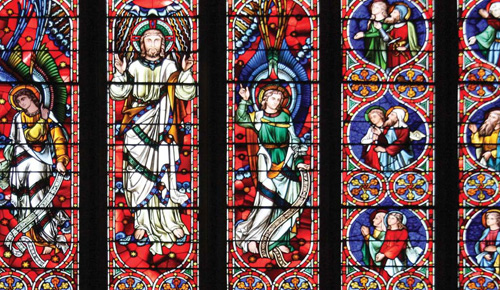
Stained Glass Window in Saint Patrick’s Cathedral, Melbourne
The main causes of fire loss are burning candles left unattended, electrical malfunction of equipment and arson
The facilities at each church vary considerably and are dependent on a number of factors, particularly age, size and architecture. In our experience, churches are rarely equipped with air conditioning or sprinkler systems but heating, particularly natural gas heating, is common. Of course, we must remember that our churches are not “old” by European standards. Australia was settled by Europeans only a little more than 200 years ago, so an ‘old’ church in Australia was built only 150 years ago.
Alarms are also not common in Australian churches. However, Catholic Church Insurances is currently funding the installation of state-of-the-art VESDA (Very Early Smoke Detection Apparatus) systems in all cathedrals and major churches in Australia. This program will involve the installation of this equipment in more than 35 buildings at a cost of many millions of dollars and will take more than 5 years to complete. This is being undertaken as part of a national project aimed at offering better physical protection to the Church’s many significant cathedrals, which are integral to the Catholic community.
Catholic Church Insurances is currently funding the installation of early smoke detection systems in all cathedrals and major churches in Australia
Australia is a continent prone to several
natural hazards such as earthquakes, fire
following quake and tropical cyclones, for
instance. Are there specific Cat Models
to calculate losses for your portfolio following
these events?
Unfortunately, Australia is prone to a large
number of catastrophic events, particularly
bushfires, and storm losses. While the industry
suffered a significant earthquake
loss in 1989, such an event is rare.
Historically, our own portfolio has not suffered many significant catastrophic losses due to the physical spread of insured assets, the relatively small value of Church-owned structures located outside the major cities and the fact that many Church buildings are constructed in higher areas, giving them natural protection against flood and water losses.
Catholic Church Insurances does not use any specific Cat Models to calculate losses following a catastrophic event, but we do use catastrophe modelling to estimate probable maximum loss and therefore to indicate the level of catastrophe cover which we require. Modelling is based on thousands of simulated catastrophic events. To be able to make a comparison to actual losses, we would need to find a simulated catastrophe that exactly matched the event’s characteristics, which would be quite difficult.
We provide underwriting data to our reinsurance broker, Aon Benfield, who performs the modelling exercise using the RMS (Risk Management Services) software for earthquake and cyclone exposure and through Impact Forecasting (an Aon-based software) for all other perils such as bushfire, flood, storm and hail.
The results and assumptions are analysed and a recommendation is made on the level of catastrophe protection required using a one-in-300 year loss event, which exceeds the minimum requirement of the industry regulator, the Australian Prudential Regulation Authority (APRA). We have a large volume of data on our insured risks, since we are in constant contact with our clients and this enables us to provide accurate, detailed and up-to-date information.
Australia was settled by Europeans only a little more than 200 years ago, so an ‘old’ church in Australia was built only 150 years ago
Australia is a young country and so are its
buildings. Do you think that churches are
more resistant to these natural perils than
for example, those in the United Kingdom?
As our expertise is based on the Australian market, it is difficult to provide an objective
comparison of buildings in Australia to those
in the United Kingdom and we have not undertaken
a study for this analysis. However,
since our early construction methods were
based on those used in England at the time,
it is likely there would be no significant difference
in the resistance to damage in both
countries.
Unlike Europe, most buildings in Australia are under 100 years of age and our “very old” structures are only 150 years old. This makes them modern by world standards. They range from early traditional buildings, usually constructed of local bluestone, limestone or sandstone, through to more contemporary buildings usually of brick construction. Where possible Catholic churches are built on higher ground, which reduces the risk of flood damage, and constructed with knowledge of the prevailing natural perils. Our experience indicates that while the building of churches on higher ground reduces the risk of flood damage, it can increase the risk of loss caused by wind and storm damage and we have suffered some large losses from these perils.
Is there any international forum where
technical opinions on the insurance of this
very special type of risks can be exchanged?
Do parishes receive from the Vatican
any sort of recommendations when
purchasing specific insurance products?
What about the art heritage?
We are not aware of any international forum
and we do not participate in any such
gathering. However, occasionally we do visit
similar Church insurers in other parts
of the world to discuss matters of common
interest and that close association
has enabled us to compare their portfolios
with our own and to receive information of
matters of similar interest, especially large
loss events and risk management issues.
The Vatican does not offer assistance in this area on a world-wide basis. Generally, each diocese and religious congregation is independent and therefore conducts its own affairs in matters such as insurance. Occasionally, we do seek the guidance of our reinsurers to assist us with risk management advice, which is based on their international experience and knowledge.
The purchase of insurance products and coverage is decided at a local level and the owners of art within a diocese or parish are responsible for arranging the appropriate level of insurance. Catholic Church Insurances is able to help the diocese with the selection of the most suitable insurance program and level of cover. Of course, we purchase relevant reinsurance protection for specific risks, such as high sums insured or heritage buildings.
While the building of churches on higher ground reduces the risk of flood damage, it can increase the risk of loss caused by wind and storm damage and we have suffered some large losses from these perils
Catholic Church Insurances also plays an
important role towards its clients by offering
tailored made Risk Management Programs.
How is it organized internally to
accomplish this aim?
We have about 30 employees who visit our
clients regularly to discuss their insurance
needs and assist them with policy and
claims matters. These staff members are
the key contacts with our clients and risk
management services are coordinated
though them. They introduce their client,
usually a senior manager within an archdiocese,
diocese or congregation, to one of
our Risk Consultants who outlines the range
of risk management services available
and works with the client’s manager to determine
what the risk management need is
and how best to deliver that service.
This particular service is undergoing significant changes within our company. Historically, we have delivered risk management services to each parish or school and our focus now is to deliver that facility at a diocesan level so that better and more consistent services are provided at a higher level, which will then ‘filter’ down to individual parishes and schools.
Our Risk Consultants are responsible for the delivery of our risk services in a coordinated and systematic manner and for the reporting of all risk management activities to the diocesan manager.
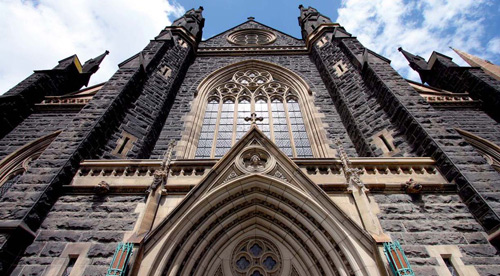
Saint Patrick’s Cathedral, Melbourne
We have heard that Catholic Church Insurances
dealt with all insurance coverage
of the recent Pope’s trip to Australia. What
were the different aspects, activities and
covers involved?
In July 2008, the Australian Church was honoured
to be chosen as the host of World Youth Day, the highlight of which was of
course a visit by His Holiness, Pope Benedict
XVI. This huge event presented us with
many challenges and opportunities.
Catholic Church Insurances provided cover for major events including the Journey of the Cross, Icon of the Blessed Virgin Mary and the indigenous message stick, which attracted some 70,000 international pilgrims. The arrival of the Holy Father on Sydney Harbour attracted a crowd of 500,000 people lining the waterfront to catch a glimpse and to attend the welcoming Mass. Later in the week, there was the dramatic re-enactment of the Stations of the Cross, which was staged in six different locations around the city of Sydney. Other challenges were the 300 Catecheses sessions conducted in venues throughout the city and home-stay programs to accommodate the many pilgrims in dioceses throughout Australia, before they converged on Sydney for the major events.
The celebration of the next World Youth Day will be held in Madrid in 2011 and we extend our best wishes to the residents of and visitors to that city at that special time
The culmination of the week was the final Mass, concelebrated by His Holiness and the Archbishop of Sydney, Cardinal George Pell. This was attended by more than 500,000 people and televised throughout the world.
In addition to undertaking all the insurance requirements, Catholic Church Insurances contributed about AUD10 million (AUD 7.6 million) in support of the occasion and was heavily involved in the organising of many activities at both diocesan and congregational level.
Specific insurance covers which we provided include:
- Transit insurance for the Cross, Religious Icon and message stick from the moment they departed Johannesburg and throughout their journey in South East Asia, Oceania and finally around Australia before arriving in Sydney.
- Construction or Contract Works insurance, which provided cover for the erection and dismantling of the stages and other facilities in Sydney.
- Composite Risks Property insurance covering hired temporary facilities at schools and colleges where visiting pilgrims stayed while in Australia.
- Voluntary Workers Personal Accident insurance for the 8,000 volunteers.
- Public liability insurance with a high indemnity limit of AUD500 million (AUD 380 million) to allow for the several hundred thousand people who attended some events.
- A Special Risks HomeStay policy to protect hosts in the event of malicious damage or theft carried out by pilgrims. The policy was developed to encourage participation in the program by those who could offer accommodation to visitors.
The celebration of the next World Youth
Day will be held in Madrid in 2011 and we
extend our best wishes to the residents
of and visitors to that city at that special
time.
Our mission
We believe Catholic Church Insurances is unique in the Australian insurance industry. There is no other insurer which distributes its surplus annually to policyholders in the same manner we do. Every Church policyholder receives a share of this surplus. The company acts more as a mutual company, even though it is regulated in the same way as any other insurer. This principle of sharing forms the basis of a strong sense of community between us and our Church clients and makes us firmly a valued member of the family of the Catholic Church in Australia.
The company genuinely tries to assist the Church in all matters in which we can make a contribution, not just insurance and financial services. In doing so, our Church owners recognise the importance of having the company manage its insurance and related needs.
We have a strong culture within the business which is based on Catholic values but recognises that we are a diverse community. This culture underpins not only what we do but, more importantly, the manner in which we go about our day-to-day operational functions. It is reflected in our claims philosophy, our underwriting policy of accepting all Church risks and in our relationship with members of the Church community.
Rather than seeing ourselves as an insurance company whose clients are the various entities of the Catholic Church in Australia, we consider that the company is principally a part of the Catholic community which manages its insurance and related needs. This is a subtle but critical distinction.
Our insurance products

Although Catholic Church Insurances would be categorised as a “specialist or niche underwriter”, we have the ability to provide the full suite of insurance policies available in the general insurance market. That translates to a large number of insurance products. However, more than 90% of our premium income comes from property (fire and associated perils), public liability and workers’ compensation business. Our full range of products for schools includes:
- Boat insurance, covering watercraft such as rowing sculls, sail boats and power boats.
- Composite risks property insurance, covering physical loss or damage to buildings and contents as a result of fire, explosion, natural disasters, theft, vandalism or accidental damage.
- Construction insurance, covering physical loss or damage as a result of contract works. Cover can also be provided for tools and equipment, temporary buildings, demolition and removal of debris as well as architect, engineer and surveyors’ consulting fees.
- Electronic equipment insurance, cover for the repair or replacement of electronic equipment due to breakdown. This policy can be extended to cover reconstruction of damaged data and increased costs associated with using substitute equipment
- Employee dishonesty (fidelity guarantee), covering school money, negotiable instruments, goods or other property against theft, embezzlement or misappropriation by employees.
- Goods in transit insurance, cover against loss or damage to property whilst in transit within Australia.
- Machinery breakdown insurance, cover for repairs required due to sudden damage, i.e. not maintenance related.
- Motor insurance, covering motor vehicles and drivers against loss or damage. The policy also provides legal liability protection for damage to third parties.
- Pluvius (rain) insurance, a policy designed to reimburse costs, expenses and nonrefundable charges incurred at a fete, social or other fundraising activity where rain would be likely to cause a reduction in support and income.
- Special risk insurance, offering cover for a wide range of items such as sporting equipment and musical instruments against loss, damage or destruction caused by an accident or misfortune arising from fortuitous circumstances.
- Directors’ and officers’ liability insurance, designed to protect against claims made against directors or officers by reason of a wrongful acts. This policy also indemnifies the school.
- Employment practices liability insurance, covering the school, past and present directors, officers and all employees against a range of events including wrongful failure to promote an employee, unlawful discrimination and sexual harassment.
- Employment practices liability insurance, covering the school, past and present directors, officers and all employees against a range of events including wrongful failure to promote an employee, unlawful discrimination and sexual harassment.
- Public liability insurance, pays compensation on behalf of the school to third parties in respect of personal injury, property damage and advertising liability. Cover is also provided for liability arising out of the school’s products i.e. anything manufactured, constructed, treated, sold or the like.
- Workers’ compensation (employers’ liability) insurance pays compensation to employees for injuries received while in the school’s employment or for work related illness such as stress.
- Personal accident and illness insurance. Protection for school employees and voluntary workers (including parents and friends), providing lump sum and weekly benefits and in some cases limited medical expenses.
- SchoolCare students’ accident insurance, covers school excursions and work experience and offers lump sum benefits for death, disablement, broken bones and damaged teeth. Medical expense, emergency transport and home tuition may also be payable. 24 hour cover is also available.
- Medical malpractice insurance indemnifies clients for claims which arise out of an act, error or omission or negligence in the provision of professional services. Features include provision for legal costs and indemnity for any claims arising from ‘Good Samaritan’ acts.
Of course, most of these policies are adapted to suit the needs of the various entities of the Catholic Church, not just schools.
1R.O.E. EUR 1 = AUD 1.41


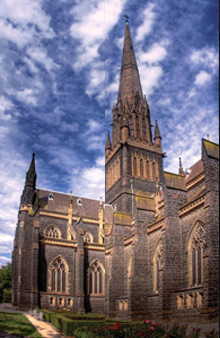
Saint Patrick’s Cathedral, Melbourne
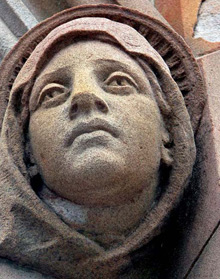
Carved figure in Saint Patrick’s Cathedral facade, Melbourne
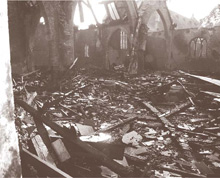
Damages by fire at Saint Joseph’s parish church, Collingwood, 2008
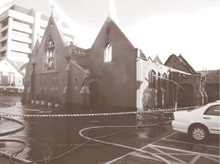
Damages by fire at Saint Joseph’s parish church, Collingwood, 2008

